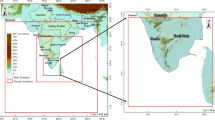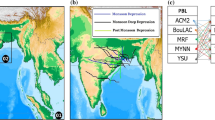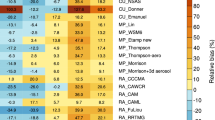Abstract
This study evaluated the ability of Weather Research and Forecasting (WRF) multi-physics ensembles to simulate storm systems known as East Coast Lows (ECLs). ECLs are intense low-pressure systems that develop off the eastern coast of Australia. These systems can cause significant damage to the region. On the other hand, the systems are also beneficial as they generate the majority of high inflow to coastal reservoirs. It is the common interest of both hazard control and water management to correctly capture the ECL features in modeling, in particular, to reproduce the observed spatial rainfall patterns. We simulated eight ECL events using WRF with 36 model configurations, each comprising physics scheme combinations of two planetary boundary layer (pbl), two cumulus (cu), three microphysics (mp), and three radiation (ra) schemes. The performance of each physics scheme combination and the ensembles of multiple physics scheme combinations were evaluated separately. Results show that using the ensemble average gives higher skill than the median performer within the ensemble. More importantly, choosing a composite average of the better performing pbl and cu schemes can substantially improve the representation of high rainfall both spatially and quantitatively.




Similar content being viewed by others
References
Awan NK, Truhetz H, Gobiet A (2011) Parameterization-induced error characteristics of MM5 and WRF operated in climate mode over the Alpine Region: an ensemble-based analysis. J Clim 24:3107–3123. doi:10.1175/2011JCLI3674.1
Betts AK (1986) A new convective adjustment scheme. Part I: observational and theoretical basis. Q J Roy Meteorol Soc 121:255–270
Betts AK, Miller MJ (1986) A new convective adjustment scheme. Part II: single column tests using GATE wave, BOMEX, and arctic air-mass data sets. Q J Roy Meteorol Soc 121:693–709
Carril AF, Mene’ndez CG, Remedio ARC (2012) Performance of a multi-RCM ensemble for South Eastern South America. Clim Dyn 39:2747–2768
Chen F, Dudhia J (2001) Coupling an advanced land-surface/ hydrology model with the Penn State/ NCAR MM5 modeling system. Part I: model description and implementation. Mon Weather Rev 129:569–585
Clough SA, Shephard MW, Mlawer EJ, Delamere JS, Iacono MJ, Cady-Pereira K, Boukabara S, Brown PD (2005) Atmospheric radiative transfer modeling: a summary of the AER codes. J Quant Spectrosc Radiat Transf 91:233–244
Cocke S, LaRow TE (2000) Seasonal predictions using a regional spectral model embedded within a coupled ocean–atmosphere model. Mon Weather Rev 128:689–708
Collins WD, Rash PJ, Boville BA, Hack JJ, McCaa JR, Williamson DL, Kiehl JT, Briegleb B (2004) Description of the NCAR community atmosphere model (CAM 3 0), NCAR technical note, NCAR/TN-464 + STR, 226 pp
Dee DP et al (2011) The ERA-Interim reanalysis: configuration and performance of the data assimilation system. Q J R Meteorol Soc 137:553–597
Dudhia J (1989) Numerical study of convection observed during the winter monsoon experiment using a mesoscale two-dimensional model. J Atmos Sci 46:3077–3107
Evans J P, and McCabe M F (2010) Regional climate simulation over Australia’s Murray-Darling basin: A multitemporal assessment. J Geophys Res 115, Issue D14. doi:10.1029/2010JD013816
Evans JP, McCabe MF (2013) Effect of model resolution on a regional climate model simulation over southeast Australia. Clim Res. doi:10.3354/cr01151
Evans JP, Westra S (2012) Investigating the mechanisms of diurnal rainfall variability using a regional climate model. J Clim 25:7232–7247. doi:10.1175/JCLI-D-11-00616.1
Evans JP, Ekstrom M, Ji F (2012) Evaluating the performance of a WRF physics ensemble over South-East Australia. Clim Dyn 39:1241–1258. doi:10.1007/s00382-011-1244-5
Fraedrich K, Leslie LM (1987) Combining predictive schemes in short-term forecasting. Mon Weather Rev 115:1640–1644. doi:10.1175/1520-0493
Hagedorn R, Doblas-Reyes F, Palmer T (2005) The rationale behind the success of multi-model ensembles in seasonal forecasting—I. basic concept. Tellus Ser A Dyn Meteorol Oceanogr 57:219–233
Hong S-Y, Lim J-OJ (2006) The WRF single-moment 6-class microphysics scheme (WSM6). J Kor Meteor Soc 42:129–151
Hong S-Y, Dudhia J, Chen S-H (2004) A revised approach to ice microphysical processes for the bulk parameterization of clouds and precipitation. Mon Weather Rev 132:103–120
Hong SY, Noh Y, Dudhia J (2006) A new vertical diffusion package with an explicit treatment of entrainment processes. Mon Weather Rev 134:2318–2341
Ishizaki Y, Nakaegawa T, Takayabu I (2012) Validation of precipitation over Japan during 1985–2004 simulated by three regional climate models and two multi-model ensemble means. Clim Dyn 39:185–206
Janjic ZI (1994) The step-mountain eta coordinate model: further developments of the convection, viscous sublayer and turbulence closure schemes. Mon Weather Rev 122:927–945
Janjic ZI (2000) Comments on “Development and evaluation of a convection scheme for use in climate models”. J Atmos Sci 57:3686
Jankov I, Gallus W Jr, Segal M, Shaw B, Koch S (2005) The impact of different WRF model physical parameterizations and their interactions on warm season MCS rainfall. Weather Forecast 20:1048–1060
Jones D, Wang W, Fawcett R (2009) High-quality spatial climate data-sets for Australia. Aust Meteorol Mag 58:233–248
Kain JS (2004) The Kain-Fritsch convective parameterization: an update. J Appl Meteorol 43:170–181
Kain JS, Fritsch JM (1990) A one-dimensional entraining/ detraining plume model and its application in convective parameterization. J Atmos Sci 47:2784–2802
Kain JS, Fritsch JM (1993) Convective parameterization for mesoscale models: the Kain-Fritsch scheme, the representation of cumulus convection in numerical models. In: Emanuel KA, Raymond DJ (eds) Amer Meteor Soc 246 pp
Mlawer EJ, Taubman SJ, Brown PD, Iacono MJ, Clough SA (1997) Radiative transfer for inhomogeneous atmosphere: RRTM, a validated correlated-k model for the long-wave. J Geophys Res 102:16663–16682
Paulson CA (1970) The mathematical representation of wind speed and temperature profiles in the unstable atmospheric surface layer. J Appl Meteorol 9:857–861
Pepler AS, Rakich CS (2010) Extreme inflow events and synoptic forcing in Sydney catchments. IOP Conf Ser: Earth Environ Sci (EES) 11(012010). doi:10.1088/1755-1315/11/1/012010
Phillips TJ, Gleckler PJ (2006) Evaluation of continental precipitation in 20th century climate simulations: the utility of multimodel statistics. Water Resour Res 42(3). doi: 10.1029/2005WR004313
Schaller N, Mahlstein I, Cermak J, Knutti R (2011) Analyzing precipitation projections: a comparison of different approaches to climate model evaluation. J Geophys Res 116(10). doi: 10.1029/2010JD014963
Schwartz CS, Kain JS, Weiss SJ, Xue M, Bright DR, Kong F, Thomas KW, Levit JJ, Coniglio MC, Wandishin MS (2010) Toward improved convection-allowing ensembles: model physics sensitivities and optimizing probabilistic guidance with small ensemble membership. Weather Forecast 25:263–280. doi:10.1175/2009WAF2222267.1
Skamarock WC, Klemp JB, Dudhia J, Gill DO, Barker DM, Duda M, Huang XY, Wang W, Powers JG (2008) A description of the advanced research WRF version 3. NCAR, Boulder, NCAR Technical Note
Speer M, Wiles P, Pepler A (2009) Low pressure systems off the New South Wales coast and associated hazardous weather: establishment of a database. Aust Meteorol Oceanogr J 58:29–39
Webb EK (1970) Profile relationships: the log-linear range, and extension to strong stability. Q J Roy Meteorol Soc 96:67–90
Wilks DS (2006) Statistical methods in the atmospheric sciences, 2nd edn. Academic Press, Amsterdam, p 627, International Geophysics Series, 91
Yuan X, Liang XZ (2011) Improving cold season precipitation prediction by the nested CWRF-CFS system. Geophys Res Lett 38, L02706. doi:10.1029/2010GL046104
Yuan X, Liang XZ, Wood EF (2012) WRF ensemble downscaling seasonal forecasts of China winter precipitation during 1982–2008. Clim Dyn 39:2041–2058. doi:10.1007/s00382-011-1241-8
Acknowledgments
This work is made possible by funding from the NSW Environmental Trust for the ESCCI-ECL project, the NSW Office of Environment and Heritage backed NSW/ACT Regional Climate Modelling Project (NARCliM), and the Australian Research Council as part of the Discovery Project DP0772665 and Linkage Project LP120200777. Thanks to the South Eastern Australian Climate Initiative (SEACI) for funding the CSIRO contribution to this study. This research was undertaken on the NCI National Facility in Canberra, Australia, which is supported by the Australian Commonwealth Government.
Author information
Authors and Affiliations
Corresponding author
Rights and permissions
About this article
Cite this article
Ji, F., Ekström, M., Evans, J.P. et al. Evaluating rainfall patterns using physics scheme ensembles from a regional atmospheric model. Theor Appl Climatol 115, 297–304 (2014). https://doi.org/10.1007/s00704-013-0904-2
Received:
Accepted:
Published:
Issue Date:
DOI: https://doi.org/10.1007/s00704-013-0904-2




